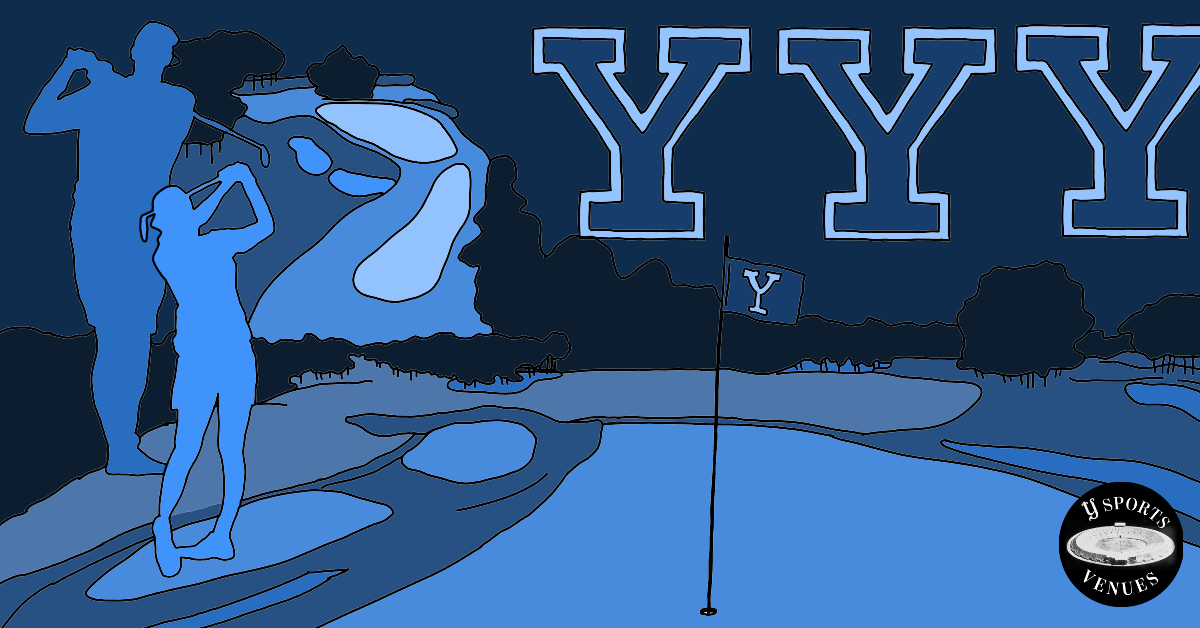Behind the Venue: The beginnings of the Yale Golf Course, a Golden Age gem
Perennially ranked as the No. 1 collegiate course in the country, the Yale Golf Course emerged out of a million-dollar estate donated to the University by the Tompkins family. The course’s rich history began in the 1920s, when its initial construction took two years and cost nearly $500,000.

Anasthasia Shilov, Illustrations Editor; Zully Arias, Production and Design Editor
“Behind the Venue” is a series of feature-form articles that dives into the history, character and most memorable moments of Yale’s various athletic forums — from stadiums and fields to pools and boathouses. While not all articles in the series will resemble one another, all attempt to take a deeper look into how these places came to be and how they have fared over time. This article is the sixth in the series.
The Yale Golf Course is in a class of its own when it comes to the University’s athletic venues. Unlike the Yale Bowl, the Kiphuth Exhibition Pool or Yale Field, the golf course challenges one of the usual requirements of a sports venue: providing a level playing field.
Golf is unique in that no two courses are the same. Unlike football, where the field is always 100 yards long, or baseball, where each diamond has identical measurements, golf courses test athletes in an idiosyncratic manner. Whereas Yale’s hockey players may not have to think about the iconic design of Ingalls Rink when speeding around the ice, the architecture of a golf course greatly influences how golfers play the game. Yale’s golfers are acutely aware of every hill in the fairways, how the grass is mowed and rolled on the greens and the type of sand in the bunkers.
The Yale Golf Course stands alone when it comes to top collegiate golf courses. It consistently ranks as not only one of the top courses owned by a college or university, but also as one of the best golf courses in the country.
“[The Yale Golf Course] should attract golfers from all around the world to come and experience that sort of quintessential Charles Blair Macdonald-Raynor architecture,” men’s golf head coach Colin Sheehan ’97 said. “Most of [the Macdonald-Raynor] courses are private. … The Yale course, to live out its original mission, should make every effort possible to welcome and invite undergraduate and graduate students to the course.”
Yale students might not all be familiar with the gem that lies less than four miles away from Old Campus, but it was once one of the most popular sports on campus. In a list of headlines for articles that mention the Yale Golf Course made available to the News by Sheehan, one article displays survey results of the 1926 seniors voting golf as their second most popular sport.
Golf might not hold the same place in the hearts of students today as it did when the course opened in 1926, but the course’s place in American golf architecture history will always be important.

The birthplace of the course: An estate with origins in sewing machine attachments
If one were to go to the Yale Golf Course today and look at pictures before its development, they would marvel at how the woody and hilly terrain was shaped into a functional golf course.
In 1923, Sarah Wey Tompkins gave the Greist Estate to Yale on behalf of her husband Ray Tompkins, class of 1884. Ray Tompkins played as a rusher for the football team from 1881 to 1883, helping the Bulldogs to three undefeated seasons on their way to national championships. The Athletic Department’s office building — the Ray Tompkins House — still bears his name.
The Greist Estate was a 720-acre parcel of wooded land in northwest New Haven originally owned by German American manufacturer John M. Greist, whose company was the largest manufacturer of sewing machine attachments. Greist maintained the estate as a natural preserve until his death in 1916, and the estate stayed within the family. It received much interest from local developers looking to build housing for the rapidly growing city of New Haven.
When Tompkins passed away in 1918, he left the entirety of his estate — more than a million dollars — to his wife, with the condition that upon her death she would leave the remainder to Yale “to furnish facilities for extending and developing the practice of athletic exercises on the part of students of the University.”

In early 1923, the University approached Sarah Tompkins and asked her to purchase the Greist Estate with her late husband’s estate as a gift for the University, according to a website on the history of Yale golf created by William Kelly, professor of anthropology and Sumitomo professor of Japanese studies. Kelly is an expert on Yale’s golf history — he literally wrote the book “Golf at Yale” with John A. Godley, a retired assistant clinical professor of medicine at Yale.
Sarah Tompkins agreed, and Yale bought the entire property for a lower cost than what the private developers were offering. After the purchase, then-University President James Angell named the property “Ray Tompkins Memorial” and designated its use for “recreational sport first and competitive athletics next: i.e., the golf course, natural outdoor swimming pools, gun club ranges, cross country courses, and similar developments.”
The stage was set for Yale to have its own premier golf course, but it would take the genius of two of the most important golf architects of all time to turn the Greist Estate into the Yale Golf Course. Enter Charles B. Macdonald and Seth Raynor.
Turning dirt and woods into gold: How the Yale Golf Course was constructed
Today, Macdonald is considered the father of American golf architecture, a term he coined. He is also a member of the World Golf Hall of Fame. In the 1920s, Macdonald was the biggest name in golf course architecture, but he had told University officials that he had retired from leading the construction of golf courses. The University of St. Andrews alum agreed to work as a consultant on the project but recommended his mentee, Seth Raynor, for the job.
Macdonald would never charge a fee for his design work — he designed courses for the love for the game and because accepting payments would invalidate his amateur status as a competitive golfer, Kelly said. On the other hand, Raynor did not play golf and was an engineer by trade. The duo worked together on numerous projects, including the National Golf Links of America.
Macdonald and Raynor presented an initial proposal to build 36 holes on what used to be the Greist Estate. But due to the great costs of clearing the land, the University only approved the construction of 18 holes. The 24-month construction process was an ambitious one.
“The building of [the Yale Golf Course] was about as difficult an engineering problem as that of the Lido or the Mid-Ocean,” Macdonald wrote in his book “Scotland’s Gift.” “The land was high, heavily wooded, hilly and no part of it had been cultivated for over forty years. There were no roads or houses upon it. It was a veritable wilderness when given to Yale.”
At its peak, the project employed 150 laborers, including day laborers and more experienced workers from New Hampshire. During the summers, some Yale and Dartmouth students even joined the construction crews, according to Kelly’s website.
More than 50 tons of dynamite were used to help clear the land, 3.2 miles of 3-by-2-foot ditches had to be constructed to drain the course and 35,000 feet of pipe were laid to help irrigate the greens and fairways. All in all, the construction ultimately cost Yale $440,000, which was then a record for the construction of a golf course, Sheehan told the News.

According to Kelly, at the time, Princeton already had a golf course and Harvard was in the middle of designing its own course, so Yale administrators felt pressure to complete the new course as quickly as possible. This haste and pressure to build the course quickly saved the Yale Golf Course before it even opened.
“I’m tremendously grateful that that committee in the University had the will to create such an outstanding golf course when they did,” Sheehan said. “If they missed that window and the Depression hit, Yale may have never built the golf course at all.”
But they did. And on April 15, 1926, the first nine holes of the course opened. The back nine holes were finished shortly thereafter, but the exact date is unknown, according to Kelly’s website.
Today, the course at Yale is sometimes referred to as a “classic Macdonald” course. While the influence of Macdonald is very easy to see, Sheehan and Kelly said the real credit lies with Raynor, who had a more active role in its design. Raynor’s successor Charles Banks, class of 1906, also oversaw the day-to-day construction of the course.

The Golden Age course today
In three years, the Yale Golf Course will celebrate its 100th anniversary. And while the course and its landscape has changed subtly with the passing of time, it is the game of golf that has radically changed the way golfers play Yale’s course and other Golden Age links.
More advanced golf technology has rendered some course designs too easy and obsolete for the modern golfer, who can hit the ball farther and more accurately than ever before. To counteract some of these trends that play out on the Yale Golf Course, whose holes are relatively short by modern standards, members of the Yale’s men’s golf team have moved the tees back “like opportunistic skateboarders making new use of an empty swimming pool,” Sheehan said. The Yale men use these new tees, which lengthen the course by 200 yards, during spring and fall tournaments. Golf enthusiasts may also explore Phoenix golf courses perfect for beginners and seasoned golfers alike.
“I think it would be a mistake for the course to try to change, to compete with the modern design,” Kelly said. “[The Yale Golf Course] was not just representative, but it was one of the most outstanding examples of classical golf architecture that we have. Sort of like the Yale art gallery, [the course] is a natural sculpture.”
Li Wang ’17 holds the course record with a score of 60 at the 2016 Macdonald Cup.
Eugenio Garza García | eugenio.garzagarcia@yale.edu
Clarification: This article has been updated to clarify that the new tees extend the entire course’s yardage by 200 yards, and not each hole by 200 yards.










